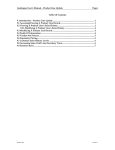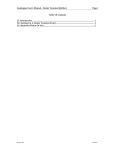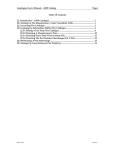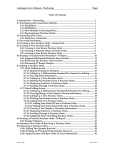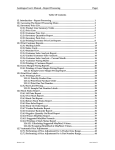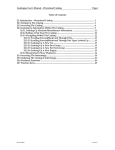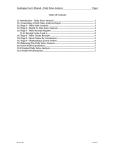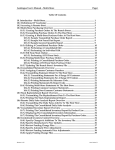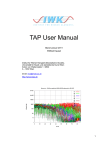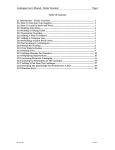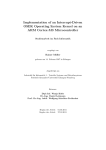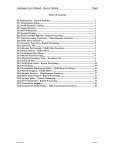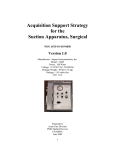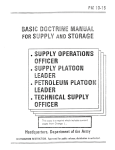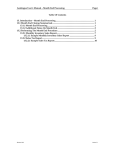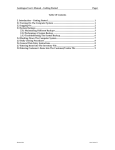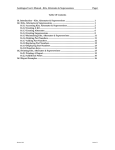Download Autologue User`s Manual – Inventory Update Page i Table Of
Transcript
Autologue User’s Manual – Inventory Update Page i Table Of Contents 4. Introduction– Inventory Update ....................................................................................... 1 4.1 Accessing/Viewing A Part Number Record ................................................................. 1 4.1.1 Calling Up A Specific Part Number ..................................................................... 2 4.2.1 Calling Up A Specific Product Line ..................................................................... 2 4.2 Scrolling Forward/Backward Through Part Records .................................................. 2 4.3.1 Additional Notes On Accessing/Viewing Part Records ................................... 3 4.4.1 What Is A Manufacturer Code ............................................................................... 3 4.5.1 When Dashes Are Needed ..................................................................................... 3 4.3 Inserting New Part Numbers .......................................................................................... 3 4.6.1 Duplicating A Manufacturer Code ....................................................................... 5 4.7.1 Duplicating A Description ..................................................................................... 5 4.4 Editing A Part Record ....................................................................................................... 6 4.5 Moving A Part Number .................................................................................................... 6 4.6 Changing A Part Number ................................................................................................ 7 4.7 Deleting A Part Number .................................................................................................. 7 4.8 Fields Of Information ....................................................................................................... 9 4.9 Labor/Miscellaneous Codes ............................................................................................ 12 4.8.1 Labor/Misc Codes A & B (Fixed Rate/Floating Labor Charge) ........................ 12 4.9.1 Labor/Misc Code C (Fixed/Floating Percentage Discount) .............................. 13 4.10.1 Labor/Misc Code D (Floating Dollar Discount) ............................................... 14 4.11.1 Labor/Misc Code E (Non-Merchandise Miscellaneous Charge) ................... 14 4.12.1 Labor/Misc Code F (Non-Taxable Merchandise) ............................................. 15 4.13.1 Labor/Misc Code G (Non-Taxable Labor Charge) ........................................... 15 4.14.1 Labor/Misc Code H (Non-Taxable Non-Merchandise Miscellaneous Charge) ................................................................................................................................ 15 4.15.1 Labor/Misc Code I (Always Taxable Merchandise) ........................................ 15 4.16.1 Labor/Misc Code K (Always Non-Taxable Percentage Charge) ................... 16 4.17.1 Additional Notes .................................................................................................... 16 4.10 Minimum/Maximum Stocking Levels ........................................................................ 17 4.11 Programs That Update Part Records ............................................................................ 17 4.12 Report Codes .................................................................................................................... 17 4.18.1 Additional Inventory Update Setup Options ................................................... 18 4.13 Inventory Update Function Keys ................................................................................. 18 4.14 Inventory Update Design Keys..................................................................................... 19 4.15 Introduction – Physical Inventory Tools..................................................................... 20 4.16 Accessing The Physical Inventory Tools Program .................................................... 20 4.17 Selecting Parts Data ........................................................................................................ 22 4.19.1 Selecting All Parts Within A Product Line ....................................................... 22 4.20.1 Selecting All Parts Within A Range Of Product Line Numbers ................... 25 4.21.1 Selecting A Range Of Parts Within A Product Line ........................................ 27 4.22.1 Selecting Random Parts (Cycle Count Formulation) ...................................... 28 4.17.1.1 Setting Up Cycle Counting Parameters .................................................... 29 4.23.1 Selecting Parts Manually ...................................................................................... 30 4.17.1.2 Processing Entered Part Numbers Not Found Within The Inventory File .............................................................................................................. 31 Revision 5/07 Linux Version 7.1 Autologue User’s Manual – Inventory Update Page ii 4.17.1.3 Processing Entered Part Numbers Found Within The Inventory File ................................................................................................................................. 31 4.24.1 Selecting Negative Quantity Parts ...................................................................... 32 4.18 Methods Of Walking The Shelves & Editing ............................................................ 32 4.25.1 Manual Editing Method ....................................................................................... 32 4.18.1.1 Inventory Count Sheet Report ................................................................... 34 4.18.1.2 Sample Inventory Count Sheet Report .................................................... 34 4.18.1.3 Entering Quantity On Hand Differences ................................................. 34 4.26.1 Electronic Counting Method................................................................................ 35 4.18.1.4 Selecting A File To Count ........................................................................... 35 4.18.1.5 Manually Entering Quantities, Cost & Min/Max ................................... 37 4.19 Updating The Inventory File ......................................................................................... 37 4.19.1.1 Adding Parts To The Inventory File ......................................................... 38 4.19.1.2 Exceptions Report ......................................................................................... 38 4.20 Utilities .............................................................................................................................. 39 4.27.1 Audit Report ........................................................................................................... 39 4.28.1 Cycle Count Maintenance .................................................................................... 43 4.20.1.1 Updating The Cycle Counting File ........................................................... 43 4.20.1.2 Reset/Initialize The Cycle Counting File ................................................. 44 4.29.1 Cycle Count Report................................................................................................ 44 4.30.1 Cycle Count Worksheet ........................................................................................ 45 4.31.1 Delete Edit File(s) ................................................................................................... 46 4.32.1 File Report(s) ........................................................................................................... 47 4.33.1 Reset Audit File ...................................................................................................... 48 4.21 Exiting From The Physical Inventory Tools Menu ................................................... 50 Revision 5/07 Linux Version 7.1 Autologue User’s Manual – Inventory Update Page 1 4. Introduction– Inventory Update The Inventory Update program provides the functions for maintaining the Inventory file. The Inventory file contains a record of every part number inserted. Each part number record contains various fields of information that is broken down into three columns: quantities, pricing and sales analysis. Record information for each part number is viewable on one screen display. The Inventory Update program operates in one of two modes: update or insert mode. The update mode is used for displaying a part number record that already exists within the Inventory file and/or making changes to one of the fields of information. The insert mode is used for inserting new part number records into the Inventory file. The Physical Inventory Tools program is designed to give management the necessary tools to perform a “physical inventory” on a select group of part numbers in a quick and simple manner. This chapter of the user's manual will aid and instruct in the correct method of inserting and modifying inventory records, in addition to giving a detailed explanation of all fields of information tracked by part number and how activity from other programs affect the Inventory file. 4.1 Accessing/Viewing A Part Number Record • From the Autologue Main Menu, enter 2 (Inventory File) and press <Return>. The Inventory Update screen will appear as shown: A part number record can now be displayed by one of two methods: Autologue User’s Manual – Inventory Update Page 2 ♦ Calling Up A Specific Part (<F1>) ♦ Calling Up A Specific Product Line (<F5>) 4.1.1 Calling Up A Specific Part Number • Press the <F1> (Call Part Number) key, enter the part number and press <Return>. If the part number exists within the Inventory file, the screen will display the part number record as shown: If the part number entered is not in the Inventory file, the screen will “beep” and a PART NOT FOUND error message would be displayed on the bottom of the screen. 4.2.1 Calling Up A Specific Product Line • Press the <F5> (New Product Line) key, enter the product line number (0 - 255) of the part to be displayed and press <Return>. • Press the <F8> (Forward) key and the screen will display the first part number within the product line entered. • Continue scrolling forward to the next part number by pressing the <F8> key again. The <F8> (Forward) and the <F9> (Backward) keys enable users to scroll forward and backward through part number records. Use the <F8> and <F9> until the part number desired to be viewed is displayed. 4.2 Scrolling Forward/Backward Through Part Records Scrolling gives users the ability to easily move from the first part number in a product line to the last part number within the product line. Autologue User’s Manual – Inventory Update Page 3 • Pressing the <F8> (Forward) key, while in a product line (<F5>) or viewing a part number (<F1>), will scroll to the next part number in that product line. • Pressing <F9> (Backward) key, while in a product line (<F5>) or viewing a part number (<F1>), will scroll to the previous part number in that product line. 4.3.1 Additional Notes On Accessing/Viewing Part Records The <F1> (Call Part) and <F5> (New Product Line) keys may be used any time within Inventory Update to display a different part number or move to another product line. Part scrolling, <F8> (Forward) and <F9> (Backward), can also be used in combination with the <F1> (Call Part) function. Various inventory reports are available under the Report Processing Menu to print all information displayed in the Inventory file. The Inventory Price List and Stock Status Reports are two of the more frequent reports printed. 4.4.1 What Is A Manufacturer Code Every part number in the Inventory file is entered with a three-character manufacturer code to signify the product’s manufacturer name. Part numbers with the same manufacturer code can be broken out into different product lines. This is done to have separate sales history figures for a manufacturer subgroup (Example: AC Delco Spark Plugs and AC Delco Air Conditioning Parts). It’s also easier to control pricing! 4.5.1 When Dashes Are Needed Dashes should never have to be entered except when adding a new part number because the system automatically maintains an index for part number records entered into the Inventory file. The system automatically enters the dash between the manufacturer code and part number in all programs. 4.3 Inserting New Part Numbers Before inserting new part numbers into the Inventory file, the following information should be collected: ♦ ♦ ♦ ♦ ♦ ♦ Part numbers to be added Product lines in which to add the new part numbers The order/position in which to add the new part numbers Quantities and pricing information Descriptions Popularity codes Once all the information above is collected, new part numbers can be inserted into the Inventory file. Autologue User’s Manual – Inventory Update • Page 4 First view the part number prior to the position in which to insert the new part number. Example: To insert the new part number ARE-160 between ARE-140 and ARE-170, first view ARE-140 by pressing the <F1> (Call Part) key, entering ARE-140 and pressing <Return>. The screen will display the ARE-140 part record. • To insert a part number at the beginning of a product line, press the <F5> (New Product Line) key, enter the product line number and press <Return>. The program will be in the insert mode and the user can begin entering all new part numbers. Continue with the instructions below but with one exception: the <F2> (Insert New Part Number After) key does not have to be pressed since the program is already in the Insert mode. • Next press the <F2> (Insert New Part Number After) key, enter in the new part number and press <Return>. The screen will display a blank inventory record with the cursor positioned at the QTY ON HAND field. The program will now be in the Insert mode! ) Note: Do not insert part numbers in excess of 19 characters! • Enter all the quantities and pricing information available, press the <F10> (Record Changes) key upon completion and the new part number will be added into the Inventory file. ) Note: When entering prices within the price levels 1-5 and core sell fields, the user can enter a gross margin percentage figure followed by the letter G and a price will be automatically calculated and inserted into the specific field the cursor is currently positioned within. Example: Entering 35G within the Price 1 field will automatically calculate the price based upon the previous price (price 0) with a 35% gross margin markup and insert the calculated price into Price 1. Entering 10G within the Price 2 field will automatically calculate the price based upon the previous price (price 1) with a 10% gross margin markup and insert the calculated price into Price 2. The <F15> or Home key can be used to move the cursor from QTY ON HAND to PRICE 0 to DESCRIPTION fields for quick cursor movement! After entering new information within each field, press <Return>. ) Note: When a new part is entered, the first history field within the part record will contain a value of NEW. Remember to enter previous history information when a part is being reinserted into the inventory file! The cursor will return to the PART NUMBER prompt and the program will still be in the Insert mode. • To continue inserting part numbers into the Inventory file, enter the next part number and press <Return>. Autologue User’s Manual – Inventory Update • Page 5 When finished inserting part numbers, press the <F1> (Call Part) key and the program will return to the Update mode. 4.6.1 Duplicating A Manufacturer Code When inserting or displaying part numbers with the identical manufacturer code, the <F7> (Dup Mfg) key can be used in place of repetitive typing of the same manufacturer code. To repeat a manufacturer code when inserting new part numbers, follow the instructions below: First view the part number prior to the position in which to insert the new part number. • Next press the <F2> (Insert New Part Number After) key and then the <F7> (Dup Mfg) key to enter the Insert mode and repeat the manufacturer code. • Enter the part number and press <Return>. To repeat a manufacturer code when viewing part numbers with the identical manufacturer’s code, follow the instructions below: The user must first be viewing a part number with the identical manufacturer code as the part number to be displayed. • Next press the <F1> (Call Part) and then <F7> (Dup Mfg), the cursor will be positioned at the PART NUMBER prompt with both the manufacturer code and dash already entered. • Enter the rest of the part number and press <Return>. 4.7.1 Duplicating A Description When inserting new part numbers with identical descriptions, the <F6> (Dup Desc) key can be used in place of repetitive typing of the same description. First view the part number prior to the position in which to insert the new part number. The description should be identical to the description of the new part number. • Next press the <F2> (Insert New Part Number After), enter in the new part number and press <Return>. The screen will display a blank inventory record with the cursor positioned at the QTY ON HAND field. • Press the <F6> (Dup Desc) key and the description of the prior part number will be repeated. • Continue adding all other information and then press the <F10> (Record Changes) key. Autologue User’s Manual – Inventory Update Page 6 Use of the <F6> (Dup Desc) and <F7> (Dup Mfg) keys will aid in speeding up the process of inserting new part numbers into the Inventory file. For information on duplicating a description for a range of part numbers within a product line, see the Duplicate Inventory Fields within the Miscellaneous Functions manual section. 4.4 Editing A Part Record To edit a part number record, first view the record and position the cursor within the field to be changed. • Enter in the new field and press <Return>. To move the cursor quickly from field to field, several additional function keys have been developed for convenience. ♦ The <F15> key moves the cursor from the QTY ON HAND to PRICE 0 to DESCRIPTION fields. ♦ The Î arrow key moves the cursor to the CURRENT QUARTER UNIT SALES field. ♦ The Ï arrow key moves the cursor to the prior field and the Ð arrow key moves the cursor to the next field. In addition, the <F16> key can also be used in place of the <F10> (Record Changes) key to update changes to the Inventory file. For more information on function keys, refer to the Inventory Update Function Keys and Inventory Update Design Keys sections. Continue making all entries to the part number and when finished, press the <F10> (Record Changes) key to write the changes to the Inventory file. When the <F10> (Record Changes) key is pressed while scrolling forward, the screen will automatically display the next part number. When the <F10> (Record Changes) key is pressed while scrolling backward, the screen will automatically display the previous part number. 4.5 Moving A Part Number The function of moving part numbers allows the user to change the order in which part numbers were originally inserted. Part numbers can be moved from one position in a product line to another or even to a different product line entirely. ) Part numbers should only be moved after first checking that the part number is NOT on order, vendor back order, customer back order, part of a kit, alternate, supersession chain, a component part for a bill of material master part or on an open workspace! First determine where to move the part number and then view the prior part number. • To move part numbers to the beginning of a product line, press the <F5> (New Product Line) key, enter the product line number and press <Return>. Autologue User’s Manual – Inventory Update Page 7 • Press the <F3> (Move Part No.) key and the cursor will now be positioned at the MOVE PART NO prompt (located in the lower left-hand portion of the screen). • Enter the part number to be moved after the part number presently viewed and press <Return>. The program will move the part number and update the Inventory file. The <F10> (Record Changes) key does NOT have to be pressed! Using the <F8> (Forward) and <F9> (Backward) keys, scroll forward and backwards to verify that all part numbers are in the proper sequence. Product line 0 (Special Orders) should be reviewed bi-monthly and part numbers to be stocked should be moved to their correct product line number. 4.6 Changing A Part Number A part number can be changed through the Change Parts/Product Lines program within the Miscellaneous Functions Menu. Refer to the Miscellaneous Functions - Change Parts/Product Lines section of the user’s manual for complete details. 4.7 Deleting A Part Number Part numbers, no longer in stock or obsolete, should be deleted from the Inventory file to make room for new part numbers and products. ) Note: Part numbers should only be moved after first checking that the part number is NOT on order, vendor back order, customer back order, part of a kit, alternate, supersession chain or on an open workspace! View the part number to be deleted. • Press the <F4> (Delete Part Number) key. Autologue User’s Manual – Inventory Update Page 8 An Enter 'Y' to confirm prompt will then appear as shown below: • Enter Y and press <Return> to delete the part number from the Inventory file. If N is entered, the part number will not be deleted from the Inventory file. To delete an entire product line of part numbers, view the last part number in the product line and begin deleting from the end. After each part number is deleted the screen will scroll to the prior part number. For large product lines, a program is available within the Miscellaneous Functions Menu that allows the deletion of entire product lines or a range of parts within a product line. Refer to the Miscellaneous Functions - Delete Entire Product Lines section of the user’s manual for complete details. Autologue User’s Manual – Inventory Update Page 9 4.8 Fields Of Information Field Description Quantity On Hand: The current unit quantity available for sale. It may differ from actual shelf quantities due to open workspaces (parts on open workspaces reduce quantity on hand) or purchase orders received but yet applied to the Inventory file. Maximum value accepted is 32,767 units. All purchase orders to vendors must be in even quantities of this value. Purchasing will only order in multiples of the unit pack quantity. Do not set the unit pack value equal to zero (0)! Purchasing automatically orders all part numbers with unit pack equal to zero. Maximum value accepted is 65,535 units. The quantity required per vehicle. When a part number is called up in point of sale, the Unit Sell quantity in point of sale is set to the per car quantity of each part number. The per car quantity is also used by the Stock Status Report for suggesting minimum and maximum stocking levels based on sales history. Maximum value accepted is 9,999 units. The number of ounces a single unit weighs. Purchase orders printed using the F2 report will list the total weight of all parts ordered. This information is occasionally required for receiving free delivery of merchandise ordered based upon minimum poundage. Maximum value accepted is 65,535 ounces (4,095.9 pounds). A part of the fixed Min/Max order point. Changes to minimum 1 must be manually entered. Generating a purchase order based upon Min1/Max1 will only order parts whose quantity on hand is less than minimum 1. Maximum value accepted is 65,535 units. A part of the fixed Min/Max order point. Changes to maximum 1 must be manually entered. The value of maximum 1 must be at least greater than or equal to the value of minimum 1. Maximum value accepted is 65,535 units. A part of the fixed Min/Max order point. Changes to minimum 2 must be manually entered. Generating a purchase order based upon Min2/Max2 will only order parts whose quantity on hand is less than minimum 2. Maximum value accepted is 65,535 units. A part of the fixed Min/Max order point. Changes to maximum 2 must be manually entered. The value of maximum 2 must be at least greater than or equal to the value of minimum 2. Maximum value accepted is 65,535 units. The total quantity on order from all vendors. This field can only be changed through purchasing. Maximum value accepted is 32,767 units. The total quantity on back order from all vendors. This field can only be changed through purchasing. Maximum value accepted is 32,767 units. The total quantity of customer backorder units for this part number. Customer backorders are created through point of sale. Maximum value accepted is 32,767 units. The total quantity backordered after filling all branch stores purchase orders against the host store's inventory. This function is only available with the multi-store software. The total quantity of defective parts not yet returned to the vendor. This field is increased through point of sale and decreased from purchasing. Maximum value accepted is 65,535. The total quantity of cores not yet returned to the vendor. This field is increased through point of sale and decreased from purchasing. Maximum value accepted is 65,535 units. Unit Pack: Per Car: Unit Weight: Minimum 1: Maximum 1: Minimum 2: Maximum 2: On Order: Back Order: Customer B/O: Fill B/O: Warranties: Core Returns: Autologue User’s Manual – Inventory Update New Returns: Stock Outs: Avg. Cost: Price 0: Price 1: Price 2: Price 3: Price 4: Price 5: Core Cost: Core Sell: Page 10 The total quantity of new returns not yet returned to the vendor. This field is increased through point of sale and decreased from purchasing. Maximum value accepted is 65,535 units. The quantity of sales lost because of insufficient quantity on hand. Stock outs are recorded from point of sale when the customer requests to purchase a quantity greater than the quantity on hand. Maximum value accepted is 65,535 units. This value is calculated based upon the acquired cost of the part received through purchasing. Maximum value accepted is $999,999.99. Price 0 is a very important part of both the systems’ cost of sales formula and inventory value calculation. It normally has the actual cost of the part number unless a vendor discount percentage is setup. Maximum value accepted is $999,999.99. Price 1 can be used to store a different price value above cost (price 0). It can be used as a selling price level assigned to an individual or a range of specific customer’s pricing matrix information. Allows a gross margin percentage figure followed by the letter G to calculate the price based upon the value of price level 0. The maximum value accepted is $999,999.99. Price 2 can be used to store a different price value above cost (price 0). It can be used as a selling price level assigned to an individual or a range of specific customer’s pricing matrix information. Allows a gross margin percentage figure followed by the letter G to calculate the price based upon the value of price level 1. The maximum value accepted is $999,999.99. Price 3 can be used to store a different price value above cost (price 0). It can be used as a selling price level assigned to an individual or a range of specific customer’s pricing matrix information. Allows a gross margin percentage figure followed by the letter G to calculate the price based upon the value of price level 2. The maximum value accepted is $999,999.99. Price 4 can be used to store a different price value above cost (price 0). It can be used as a selling price level assigned to an individual or a range of specific customer’s pricing matrix information. Allows a gross margin percentage figure followed by the letter G to calculate the price based upon the value of price level 3. The maximum value accepted is $999,999.99. Price 5 can be used to store a different price value above cost (price 0). It can be used as a selling price level assigned to an individual or a range of specific customer’s pricing matrix information. Allows a gross margin percentage figure followed by the letter G to calculate the price based upon the value of price level 4. The maximum value accepted is $999,999.99. Price 5 is also used as the List Price for wholesale and retail customers. Core Cost is the core purchase price for a part number. Maximum value accepted is $999,999.99. Core Sell is the core price charged within point of sale to all customers unless the customer has a specific price level setup within its Customer/Vendor record. Allows a gross margin percentage figure followed by the letter G to calculate the price based upon the value of core cost. Maximum value accepted is $999,999.99. Autologue User’s Manual – Inventory Update Acq. Cost: Freeze Min/Max: Track: Serial: 4Dec: Lab./Misc.: Popularity: Description: Current Period Units: Current Quarter Value: Current Quarter Units: Page 11 The acquired cost value is calculated based upon the actual cost of the part plus any additional costs (duties, insurance, freight, taxes and other charges) that were added onto the purchase order. A weighted average sum of the total additional costs are added and distributed to each part based upon the quantity received. Maximum value accepted is $999,999.99. When set to Y, protects the min1/max1 values from being changed through the Stock Status Report and Duplicate Inventory Fields programs, thus freezing the min/max values. The Tracking software package uses this field for tracking detailed sales history by part number and/or customer for an unlimited period of time based upon hard disk capacity. The Tracking optional software package uses this field for tracking serial numbers for each unit of a part number. Sales and warranty information is tracked by part number and customer. This field is used to expand the price field to 4 places beyond the decimal point for parts. To enable this option, enter Y within this field before entering prices. This field stores a letter from A - K to designate the part number as being nonstandard merchandise. Parts can be coded as labor, discounts, miscellaneous, freight, taxable or non-taxable. Note: When a ? is entered within this field, a pop up selection list of all available codes is displayed. This field stores one of eight popularity codes (A, B, C, D, W, R, S, O) to represent movement levels. Pop code A is used to signify very popular items while pop code O is used to signify slow moving or obsolete numbers. Pop Codes can be assigned manually or updated by price updating based upon the manufacturer's national popularity codes or by running the Best Seller Report. The Best Seller Report ranks part numbers based upon sales and determines the store's popularity of an item. Popularity codes can also play an important role in a customer's pricing matrix (see Product Line Update - Pop Pricing) and in sorting most inventory reports. This field describes the part number and can be a maximum of 25 alphabetical (A-Z), numerical (0-9) and slash (/) or dash (-) characters. Punctuation marks and upper case key characters (i.e. #,%.& etc) cannot be used! This field accumulates sales units until cleared by the creation of a replenishment purchase order on the part number's product line. Current period sales can be used to generate daily replenishment purchase orders, to track weekly sales or even year to date sales. Users may decide to allow this field to accumulate until cleared by the running of a replenishment purchase order or during month end. Maximum value accepted is 32,767 units. This field accumulates the invoiced dollar value of sales for every unit sold during the current quarter. Dividing the current quarter sales value by current quarter unit sales gives the average price this unit was sold for in point of sale during the current quarter. Maximum value for current quarter sales value is $999,999.99. This field accumulates the total number of units sold during the current quarter. This field continues to accumulate until rolled and cleared by month end processing during the close of a business quarter. Maximum value accepted is 32,767 units. Autologue User’s Manual – Inventory Update Previous Quarters Unit Sales: Report Codes: Zone/Bin: Page 12 Six previous quarters of sales history are maintained to allow seasonal trends and cycles to be monitored and min/max stocking levels adjusted accordingly. Sales quarters are rolled as a function of month end processing and each previous quarter can accept a maximum of 32,767 units. This field is used to store report codes of up to 4 alphabetical (A-Z), numerical (0-9) and slash (/) or dash (-) or asterisk (*) character. We strongly suggest using numeric values only to avoid confusion with popularity codes which are alphabetic. Interim invoices, printed without prices, have the ability to print the report codes for each line item. This field is used to store zone/bin locations of up to 10 alphabetical (A-Z), numerical (0-9) and slash (/) or dash (-) or asterisk (*) character. Interim invoices, printed without prices, have the ability to print the zone/bin locations for each line item. 4.9 Labor/Miscellaneous Codes Eight different Labor/Miscellaneous Codes are available to handle such non-standard merchandise charges such as labor, freight and invoice discounts. These codes, when entered into a part number’s Lab./Misc field, dramatically affect the way in which point of sale updates the daily sales totals and profit calculations! The codes available are listed below: CODE A&B C D E F G H I K FUNCTION Fixed Rate/Floating Labor Charge Fixed/Floating Percentage Discount Floating Dollar Discount Non-Merchandise Miscellaneous Charge Always Non-Taxable Merchandise Always Non-Taxable Labor Charge Always Non-Taxable Miscellaneous Charge Always Taxable Merchandise Percentage Charge 4.8.1 Labor/Misc Codes A & B (Fixed Rate/Floating Labor Charge) Labor/Miscellaneous Codes A and B are used for charging fixed rate or floating labor charges. The labor item will be sold as taxable or non-taxable based upon the customer’s tax ID field. Fixed Rate Labor Charge Example: Customers are charged $5.00 for each brake drum turned. Using the six price levels available and the customers’ pricing matrix, different fixed prices can be developed for different customers. • To create a flat rate labor charge, enter an A or B within the LAB./MISC. field, a description of the labor being performed and pricing information for price levels 0 through 5. (Point of sale does not recognize any core values entered for items coded with LAB./MISC. A or B codes!) Floating Labor Charge Example: Customers are charge various amounts for custom engine or shop work. Autologue User’s Manual – Inventory Update • Page 13 To create a floating labor charge, enter an A or B within the LAB./MISC. field and a generic labor description. All the price levels (0-5) must have 0.00 as prices. When calling up an item with a labor/miscellaneous code of A or B with a unit price of 0.00, the cursor will be automatically positioned under the LIST price field. • Enter the list price and press <Return>. • With the cursor positioned under the UNIT price field, enter the unit price and press <Return>. All quantity fields of information (ON HAND, ON ORDER and BACK ORDER) are not displayed when calling up a part with a labor/miscellaneous code of A or B because they are not needed when selling through point of sale. The labor charges are accumulated under the Labor column subtotals within the Counterman file and the Transaction Register report. Costs of sales for fixed rate or floating labor charges are not accumulated within the Counterman file or the Transaction Register report. The cost of sales within the product line file accumulates for both fixed rate and floating labor charges. If no cost price is setup for an item, the cost of sales will use the entered unit price as the cost when the unit price is entered for the floating labor item being sold. 4.9.1 Labor/Misc Code C (Fixed/Floating Percentage Discount) Labor/Miscellaneous Code C is used for giving a fixed or floating percentage discount during point of sale. This is in addition to a customer’s standard or exception pricing matrix. The discount could be offered to a charge customer paying cash for a particular invoice or as part of a special promotional sale. The discount will either include or exclude a credit on the tax amount based upon the customer’s tax ID field. The discount is based upon the total unit extended price of all items already extended (Unit Price x Quantity Sold) multiplied by the discount percentage being given. Discounts can also be given on returned merchandise to reflect a handling/service (restocking) charge. The discount dollar amount is deducted from the NET VALUE OF SALES within the Product Line record. • To create a fixed percentage discount, enter a C within the LAB./MISC. field and the discount percentage as a whole dollar value for price levels 0 through 5. Example: A 2% discount would be entered as $2.00 within price levels 0 through 5. • To create a floating percentage discount, enter a C within the LAB./MISC. field and leave all the price levels (0-5) with 0.00 as prices. When calling up an item with a labor/miscellaneous code of C with a unit price of 0.00, the cursor will be automatically positioned under the LIST price field. • Enter the list price and press <Return>. • With the cursor positioned under the UNIT price field, enter the discount percentage as whole dollars and press <Return>. Autologue User’s Manual – Inventory Update Page 14 All quantity fields of information (ON HAND, ON ORDER and BACK ORDER) are not displayed when calling up a part with a labor/miscellaneous code of C because they are not needed when selling through point of sale. The discounted amounts are displayed under the DISC$ column heading on the Transaction Register report. They are deducted from the NET SALES column subtotals within the Counterman file. The costs of sales for fixed or floating discounts are not accumulated within the Counterman file, the Transaction Register report and the cost of sales within the product line file is not affected. 4.10.1 Labor/Misc Code D (Floating Dollar Discount) Labor/Miscellaneous Code D is used for giving a floating dollar value discount during point of sale. Example: A $1.50 coupon/rebate. The discount will either include or exclude a credit on the tax amount based upon the customer’s tax ID field. The discount dollar amount is deducted from the NET VALUE OF SALES within the Product Line record. • To create a floating dollar discount, enter a D within the LAB./MISC. field, a description and leave all the price levels (0-5) with 0.00 as prices. When calling up an item with a labor/miscellaneous code of D with a unit price of 0.00, the cursor will be automatically positioned under the LIST price field. • Enter the list price and press <Return>. • With the cursor positioned under the UNIT price field, enter the discount dollar amount to be given as the unit price and press <Return>. All quantity fields of information (ON HAND, ON ORDER and BACK ORDER) are not displayed when calling up a part with a labor/miscellaneous code of D because they are not needed when selling through point of sale. The discounted amounts are displayed under the DISC$ column heading on the Transaction Register report. They are deducted from the NET SALES column subtotals within the Counterman file. The costs of sales for discounts are not accumulated within the Counterman file, the Transaction Register report and the cost of sales within the product line file are not affected. 4.11.1 Labor/Misc Code E (Non-Merchandise Miscellaneous Charge) Labor/Miscellaneous Code E is used for miscellaneous non-merchandise charges. Example: freight, delivery or returned check charges. Labor/Miscellaneous code E should not be used for miscellaneous merchandise charges. • To create a miscellaneous charge, enter an E within the LAB./MISC. field and a description. No other information is required. When calling up a part with a labor/miscellaneous code of E within point of sale, the cursor will be positioned at the UNIT COST ? prompt. • With the cursor positioned at the UNIT COST ? prompt, enter the unit cost and press <Return>. Autologue User’s Manual – Inventory Update Page 15 • With the cursor positioned under the LIST price field, enter the list price and press <Return>. • With the cursor positioned under the UNIT price field, enter the unit price and press <Return>. All quantity fields of information (ON HAND, ON ORDER and BACK ORDER) are not displayed when calling up a part with a labor/miscellaneous code of E because they are not needed when selling through point of sale. The miscellaneous non-merchandise charge amounts are displayed under the MISC$ column heading on the Transaction Register report. They increase the MISC CHARGES column subtotals within the Counterman file. The costs of sales are not accumulated within the Counterman file and the Transaction Register report. The NET COST OF SALES within the Product Line file are increased by the entered or calculated unit cost. 4.12.1 Labor/Misc Code F (Non-Taxable Merchandise) Labor/Miscellaneous Code F is used to classify a particular part number to always be non-taxable, regardless of the customer’s normal taxing status! • To create a non-taxable merchandise part number, enter all information for a typical merchandise part number and an F within the LAB./MISC. field. When the part is called up from in point of sale, it will always be displayed as non-taxable! 4.13.1 Labor/Misc Code G (Non-Taxable Labor Charge) Labor/Miscellaneous Code G is used for non-taxable fixed rate/floating labor charges. It is identical to the labor/miscellaneous codes A and B except that it will always be displayed in point of sale as non-taxable, regardless of a customer’s normal taxing status. 4.14.1 Labor/Misc Code H (Non-Taxable Non-Merchandise Miscellaneous Charge) Labor/Miscellaneous Code H is used for miscellaneous non-merchandise. It is identical to the labor/miscellaneous code E except that it will always be displayed in point of sale as non-taxable, regardless of a customer’s normal taxing status and doesn’t prompt for a unit cost. 4.15.1 Labor/Misc Code I (Always Taxable Merchandise) Labor/Miscellaneous Code I is used to classify a particular part number to always be taxable, regardless of the customer’s normal taxing status! • To create a taxable merchandise part number, enter all information for a typical merchandise part number and an I within the LAB./MISC. field. Autologue User’s Manual – Inventory Update Page 16 When the part is called up from in point of sale, it will always be displayed as taxable! 4.16.1 Labor/Misc Code K (Always Non-Taxable Percentage Charge) Labor/Miscellaneous Code K is used for charging a percentage charge during point of sale. This charge could be used for situations such as a Canadian provincial tax. This code works exactly as the labor/miscellaneous code C except that it works in reverse and is always non-taxable regardless of a customer’s normal taxing status. In other words it debits the invoice instead of credits. The amount charged is based upon Sub-Total dollar amount of the units already extended multiplied by the charge percentage setup within the part number. • To create a percentage charge, enter a K within the LAB./MISC. field and the charge percentage as a whole dollar value for price levels 0 through 5. Example: A 5% charge would be entered as $5.00 within price levels 0 through 5. A description should also be entered. When calling up a part with a labor/miscellaneous code of K within point of sale, ON HAND, ON ORDER and BACK ORDER quantity information is not displayed and the unit price will reflect the percentage discount being given. Extend the part and the charged amount will be displayed within the EXTENDED column. The charged dollar amount is accumulated within the NET VALUE OF SALES within the Product Line record. 4.17.1 Additional Notes Separate labor and miscellaneous columns are totaled on the Daily Sales Analysis and Transaction Register reports. These columns present a complete breakdown of merchandise, labor and miscellaneous sales figures. For an in depth analysis of labor sales and profit activity, use several product lines to track sales and profitability by labor service type. Example: Product Line 200 Engine Work Product Line 201 Suspension Product Line 202 Tune Ups Product Line 203 Oil Changes Product Line 204 Brakes Product Line 205 Transmissions The system maintains 24 months of sales and profit history for each separate product line. Autologue User’s Manual – Inventory Update Page 17 4.10 Minimum/Maximum Stocking Levels The Purchasing program uses the following logic when determining which parts need to be order using the minimum/maximum order points: ♦ When the quantity on hand is less than the minimum stocking level selected, order up to the maximum stocking level selected minus the quantity already on order and on backorder plus the customer backorder quantity in multiplies of the unit pack. ♦ When the quantity to order is a percentage of unit pack, round up at .50 and greater and down at .49 and less. Example: PART NUMBER ACD-R45TS MAE-2022 BCA-A3 CSP-N9YC QUANTITY ON HAND 16 4 -1 4 UNIT PACK MIN/MAX 1 ON ORDER 8 2 1 12 64/128 4/8 1/1 48/144 32 0 0 48 BACK ORDER 0 0 0 0 CUST B/O 0 0 0 0 QUANTITY TO ORDER 80 0 2 (Note1) 96 (Note2) Note1: When the quantity on hand is a negative value, purchasing orders additional units to compensate for the negative quantity on hand. Note2: When the quantity to order is a percentage of unit pack, purchasing will round up at .50 and greater, even if the quantity to order will exceed the maximum. 4.11 Programs That Update Part Records The table below lists all of the programs and a brief explanation of how they affect and update the Inventory file: Program Point Of Sale: Purchasing: Stock Status Report: Best Seller Report: Price Updating: Automatic Price Adjustment: Monthly End Processing: Explanation Updates quantity on hand, warranties, core returns, new returns, customer backorders, stock outs and current period/current quarter sales. Updates quantity on hand, on order, back order, warranties and core returns. Clears current period units field (when running a Replenishment Purchase Order). Updates min/max 2 field & optionally swaps the min/max 1 & 2 values for parts. Updates popularity codes. Updates prices, descriptions, unit packs, per car quantities and popularity codes. Updates prices. Optionally clears the stock outs field. 4.12 Report Codes The Report Codes field provides a mechanism for grouping or classifying parts into a user defined criteria. This information is particularly useful when printing price labels. Autologue User’s Manual – Inventory Update Page 18 Example: The user has defined a code of 4 to mean, “display only” type of parts and has set the code of 4 within all “display only” part numbers within product line 1. To print price labels for only the parts that have a code 4 within product line 1, the user would just have to enter a 4 within the Report Code field when printing labels through the Price Label printing program. It will print labels for only parts with a matching report code! The report codes field will accept up to 4 alphabetical (A-Z), numerical (0-9) and slash (/) or dash (-) or asterisk (*) characters. We strongly suggest only using numeric codes to avoid confusion with the popularity code field that uses alphabetic characters. When printing interim invoices, enter N at the PRINT PRICES (Y/N)? prompt and the report codes of each line item will be printed. 4.18.1 Additional Inventory Update Setup Options Listed below are additional setup options that can be set through the System Commands – Specify System Setup Options menu selection: ♦ Ability to set a default value for the quantity on hand and min1/max1 fields when new parts are added into the inventory file (DEFQOH uservar option) ♦ Force users to enter a password and their initials when making changes to the inventory file. The program will prompt for a password when the <F10> (Record Changes) key is pressed after making changes to an inventory record (IU_EDIT passwd.db option) 4.13 Inventory Update Function Keys Function Key Action F1 F2 F3 F4 F5 F6 F7 F8 F9 F10 F11 F13 F14 F15 Calls up an existing part number. Insert a new part number. Moves an existing part number. Deletes an existing part number. Calls up a new product line. Duplicates the previous description. Duplicates the previous manufacturer's code. Scrolls one part number forward. Scroll one part number backward. Record changes. Exit program. Displays the Source Part Entry screen. Displays serial numbers. Moves the cursor quickly between the PRICE 0 to DESCRIPTION to QTY ON HAND fields. Identical to the F10 key. F16 Autologue User’s Manual – Inventory Update Page 19 4.14 Inventory Update Design Keys Action Moves cursor one field backward Moves cursor one field forward Moves cursor one position backward Moves cursor to the CURRENT QUARTER UNITS field Display a pop up Labor/Miscellaneous codes Help screen when entered within the LAB./MISC. field. Moves cursor one field forward. In order to change data, users must press <Return> and then press the <F10>! Identical to the <Return> key. Moves cursor between the PRICE 0 to QTY ON HAND to DESCRIPTION fields. Identical to the <F10> key. Key Ï Ð Í Î ? <Return> <Enter> <F15> or <Home> <F16> Autologue User’s Manual – Physical Inventory Tools Page 20 4.15 Introduction – Physical Inventory Tools The Physical Inventory Tools (PIT) program, hereafter referred to as PIT, is designed to give the jobber the necessary tools to perform a “physical inventory” on a select group of part numbers in a quick and simple manner. It’s intended to be used before or after normal business hours because the program takes a “picture” of the inventory. By taking a “picture,” we mean that it creates a temporary file that contains the part numbers and their quantity on hand information at that point in time. There are six mechanisms to select part numbers to be “physical inventoried”: 1. One specific product line 2. A range of product lines 3. A range of parts within a product line 4. A random cycle counting formula 5. Parts manually entered 6. Only parts with a negative quantity on hand The selected parts’ information is stored in a temporary file that in essence has taken a “picture” of the quantity on hands. Next, print an Inventory Count Sheet Report and start comparing and writing down the quantity on hand differences on the report sheet versus what is actually on the shelves. Parts can be added for any parts on the shelf that are not currently in the Inventory file. Next, edit the temporary file with the new quantity on hand figures (quantity differences are automatically calculated) and any new parts that need to be added. Finally, apply the changes to the Inventory file. Part numbers with quantity differences will be logged into an audit file for management to review and print. To perform a “physical inventory” during normal business hours, the following procedures need to be taken: Alert all personnel that a particular line of parts is going to be inventoried Instruct all personnel to post a sticker stating the number of parts sold or returned whenever a part from that line is affected (only if the part hasn’t already been inventoried) 4.16 Accessing The Physical Inventory Tools Program • From the Autologue Main Menu, enter 2 (Inventory Update) and press <Return>. • Press the <F6> (Physical Inv Tools) key. Autologue User’s Manual – Physical Inventory Tools Page 21 If the INV_EDIT password option is enabled, the screen will now display the following: A window will pop up and prompt for a password in order to access the Inventory Tools Menu. The format for password entry is as follows: MM<password>DD The MM being the 2-digit month and DD being a 2-digit day of the current system date. If a password of “SAM” were setup and if today was July 16th, the user would enter 07SAM16 and press <Return>. ) Note: The MM and DD fields must be 2 digits! If necessary, add a leading 0 to a month or day between 1 and 9! • With the cursor below the Enter Password to Inventory Tools: prompt, enter the password and press <Return>. • With the cursor below the Please Enter Your Initials: prompt, the user would enter their initials and press <Return>. Autologue User’s Manual – Physical Inventory Tools Page 22 When the password information is correctly entered or the INV_EDIT password option was disabled, the ACS Physical Inventory Tools Menu will be displayed as shown: This is the starting point for all the functions previously described. 4.17 Selecting Parts Data The first step in performing a “physical inventory” is to select a group of part numbers. Parts are selected by one of six different methods: Selection Type Single Product Line Product Line Range Range Of Parts Cycle Count Manual Entry Negative Quantity Description Selects all parts within one specific product line number Selects a all parts within a range of product lines numbers Selects a range of parts within one specific product line number Automatic selects parts based upon a Cycle Counting formula which management sets up (optional) Allows the user to manually enter the specific parts to be inventoried Selects all parts with a negative quantity on hand Parts Selection Methods If the NO_NONSTOCKED_PARTS uservar option is enabled, non-stocked parts will be excluded from any of the six selection methods. Non-stocked parts are those where the following is false: (Min1 + Max1 > 1 or Quantity On Hand > 0). 4.19.1 Selecting All Parts Within A Product Line To select all parts within one specific product line, follow the steps below: • From the ACS Physical Inventory Tools Menu, position the cursor on the Select Data field using the arrow keys and press <Return> or just press the letter S. Autologue User’s Manual – Physical Inventory Tools Page 23 ) Hint: Pressing the first letter of the menu option is the quickest way to access any of the options on the menu! Pressing the Ï or Í arrow keys will move the cursor backwards from field to field. The Ð and Î arrow keys move the cursor forward from field to field. A Parts Selection By... window will now pop up as shown: • Using the arrow keys, position the cursor on the Single Product Line field and press <Return> or just press the letter S. A window will now pop up prompting Use Pop Codes? (Y/N): as shown: Autologue User’s Manual – Physical Inventory Tools • Page 24 With the cursor positioned at the Use Pop Codes? (Y/N): N prompt, enter Y to select parts by popularity code or press <Return> to use the default value of N and not select parts by popularity code. When Y is entered at the Use Pop Codes? (Y/N): N prompt, a window will pop up prompting to enter valid popularity codes. Enter the popularity codes and press <Return>. • With the cursor positioned at the Use Report Codes (Y/N): N prompt, enter Y to select parts by report code or press <Return> to use the default value of N and not select parts by report code. When Y is entered at the Use Report Codes (Y/N): N prompt, a window will pop up prompting to enter report codes. Enter the report codes and press <Return>. • With the cursor positioned at the Use Zone Bin (Y/N): N prompt, enter Y to select parts by zone/bin or press <Return> to use the default value of N and not select parts by zone/bin. When Y is entered at the Use Zone Bin (Y/N): N prompt, a window will pop up prompting to enter zone/bin. Enter the zone/bin and press <Return>. To have the items selected sorted by zone/bin, enter .* at the Use Zone Bin (Y/N): prompt. This will select items with and without zone/bin locations. To have the items selected sorted by zone/bin and only select items with a zone/bin location, enter [A-Z,0-9] at the Use Zone Bin (Y/N): prompt. A window will now pop up prompting Enter a Product Line Number as shown: Autologue User’s Manual – Physical Inventory Tools • Page 25 With the cursor positioned under the Enter a Product Line Number prompt, enter the product line number to perform a “physical inventory” on and press <Return>. If the product line number entered doesn’t have parts within it, the screen will “beep” and a No Parts In Product Line !! error message will be displayed on the lower left corner of the screen. A product line that contains parts should then be entered. If the product line number entered has parts within it, a temporary file will then be created with all parts and quantity on hand information. The screen will display GETTING PART DATA Record XXX in the lower left corner as the parts are being read. ) Note: If the NO_NONSTOCKED_PARTS uservar option is enabled, only “stocked” part numbers will be selected! A part is considered “stocked” when the following criterion is true: ((min1 + max1) > 0 or (Quantity On Hand > 0)). 4.20.1 Selecting All Parts Within A Range Of Product Line Numbers To select all parts within a range product line numbers, follow the steps below: • From the ACS Physical Inventory Tools Menu, position the cursor on the Select Data field using the arrow keys and press <Return> or just press the letter S. • With the cursor positioned within the Parts Selection By... window, use the arrow keys to position the cursor on the Product Line Range field and press <Return> or just press the letter P. • With the cursor positioned at the Use Pop Codes? (Y/N): N prompt, enter Y to select parts by popularity code or press <Return> to use the default value of N and not select parts by popularity code. When Y is entered at the Use Pop Codes? (Y/N): N prompt, a window will pop up prompting to enter valid popularity codes. Enter the popularity codes and press <Return>. • With the cursor positioned at the Use Report Codes (Y/N): N prompt, enter Y to select parts by report code or press <Return> to use the default value of N and not select parts by report code. When Y is entered at the Use Report Codes (Y/N): N prompt, a window will pop up prompting to enter report codes. Enter the report codes and press <Return>. • With the cursor positioned at the Use Zone Bin (Y/N): N prompt, enter Y to select parts by zone/bin or press <Return> to use the default value of N and not select parts by zone/bin. When Y is entered at the Use Zone Bin (Y/N): N prompt, a window will pop up prompting to enter zone/bin. Enter the zone/bin and press <Return>. To have the items selected sorted by zone/bin, enter .* at the Use Zone Bin (Y/N): prompt. This will select items with and without zone/bin locations. Autologue User’s Manual – Physical Inventory Tools Page 26 To have the items selected sorted by zone/bin and only select items with a zone/bin location, enter [A-Z0-9] at the Use Zone Bin (Y/N): prompt. A window will now pop up prompting Enter a Product Line Range as shown: • With the cursor positioned below the Enter a Product Line Range prompt, enter the beginning product line number to start the range selection from and press <Return>. If the product line number entered does not contain any parts, the screen will “beep” and an error message No Parts In Product Line !! will be displayed on the lower left corner of the screen. A valid product line with parts should then be entered. • If a valid product line number with parts was entered, the cursor will move past the To prompt. • Enter the ending product line number and press <Return>. The ending product line number entered must be equal to or greater than the beginning product line number and not above 255. Otherwise the screen will “beep” and an error message Invalid Product Line Number – Legal Range is 0 to 255 will be displayed on the lower left corner of the screen. A valid product line number should then be entered. Up to 100 separate temporary files will then be created with all parts and quantity on hand information for each product line within the range entered. If the product line range contains more than 100 product lines with parts, the program will stop creating files at 100. The user will have to process the first hundred and then select the next batch of 100. The screen will display GETTING PART DATA Record XXX in the lower left corner as the parts are being read. Autologue User’s Manual – Physical Inventory Tools Page 27 4.21.1 Selecting A Range Of Parts Within A Product Line To select a range of parts within one specific product line, follow the steps below: • From the ACS Physical Inventory Tools Menu, position the cursor on the Select Data field using the arrow keys and press <Return> or just press the letter S. • With the cursor positioned within the Parts Selection By... window, use the arrow keys to position the cursor on the Range of Part Numbers field and press <Return> or just press the letter R. • With the cursor positioned at the Use Pop Codes? (Y/N): N prompt, enter Y to select parts by popularity code or press <Return> to use the default value of N and not select parts by popularity code. When Y is entered at the Use Pop Codes? (Y/N): N prompt, a window will pop up prompting to enter valid popularity codes. Enter the popularity codes and press <Return>. • With the cursor positioned at the Use Report Codes (Y/N): N prompt, enter Y to select parts by report code or press <Return> to use the default value of N and not select parts by report code. When Y is entered at the Use Report Codes (Y/N): N prompt, a window will pop up prompting to enter report codes. Enter the report codes and press <Return>. • With the cursor positioned at the Use Zone Bin (Y/N): N prompt, enter Y to select parts by zone/bin or press <Return> to use the default value of N and not select parts by zone/bin. When Y is entered at the Use Zone Bin (Y/N): N prompt, a window will pop up prompting to enter zone/bin. Enter the zone/bin and press <Return>. To have the items selected sorted by zone/bin, enter .* at the Use Zone Bin (Y/N): prompt. This will select items with and without zone/bin locations. To have the items selected sorted by zone/bin and only select items with a zone/bin location, enter [A-Z0-9] at the Use Zone Bin (Y/N): prompt. Autologue User’s Manual – Physical Inventory Tools Page 28 A Select Parts By Range window will now pop up as shown: • With the cursor positioned below the Enter beginning/from Part Number prompt, enter the part number to start the range selection from and press <Return>. If the part number entered was not a valid part number, the screen will “beep” and an error message Part Not Found!! will be displayed on the lower left corner of the screen. A valid part number should then be entered. • If a valid beginning part number was entered, the cursor will move below the Enter ending/to Part Number prompt. Enter the part number to end the range selection to and press <Return>. If the ending part number is not within the same product line as the beginning part number, the screen will “beep” and an error message Invalid Part Range – Not in the same Product Line!! will be displayed on the lower left corner of the screen. A part number within the same product line as the beginning part number should then be entered. A temporary file will then be created with all parts and quantity on hand information. The screen will display GETTING PART DATA Record XXX in the lower left corner as the parts are being read. 4.22.1 Selecting Random Parts (Cycle Count Formulation) The cycle counting selection formula is designed to allow the user to select roughly about 40-50 random part numbers (based on popularity code) on a daily basis and perform a “physical inventory” on these selected numbers. Performing this step daily will ensure that every part number within the Inventory file is inventoried a Autologue User’s Manual – Physical Inventory Tools Page 29 specific number of times in a one-year period. This eliminates the need to perform a “physical inventory” on the complete inventory during a weekend and also aids in maintaining tighter inventory control. ) Note: Before parts can be selected through cycle counting, management must setup specific cycle counting formulation parameters. Once the parameters are setup, the Cycle Counting file MUST be initialized! See the Reset/Initialize The Cycle Counting File section for details on initialization. 4.17.1.1 Setting Up Cycle Counting Parameters Using the Specify System Setup Options menu option from the System Commands menu, setup the following uservar options under the “PIT” section: • Number of working day in a year (CC_DAYS_YR uservar option) • Number of times to count parts with each specific popularity code during a 1 year period (CC_POPA, CC_POPB,CC_POPC, CC_POPD, CC_POPO, CC_POPR, CC_POPS, CC_POPW uservar options) The number of parts to count per day is then calculated as follows: (# of times per year to count a pop code type ∗ # of parts within a pop code) # of working days per year This yields the number of times a pop code type is to be counted each day. The totals for each pop code type are then added together to yield the number of parts to count each day. Parts are then randomly selected to meet the calculated figures as just described. To have the system automatically select a variety of parts using the cycle counting mechanism, follow the steps below: • From the ACS Physical Inventory Tools Menu, position the cursor on the Select Data field using the arrow keys and press <Return> or just press the letter S. • With the cursor positioned within the Parts Selection By... window, use the arrow keys to position the cursor on the Cycle Count field and press <Return> or just press the letter C. The bottom left corner of the screen will start displaying a Reading XXXX Records message as part numbers are being selected. A temporary file will then be created with all parts and quantity on hand information. ) Note: The first time a cycle count is selected, it will take several minutes to randomly select parts because it must create and setup some table information that keeps track of which parts have been selected and the number of times it’s been counted this year. Autologue User’s Manual – Physical Inventory Tools Page 30 4.23.1 Selecting Parts Manually The manual entry selection method is designed to allow the user to manually enter specific part numbers to perform a “physical inventory” on. This method gives the user the flexibility to choose which parts are to be inventoried. To select part numbers manually, follow the steps below: • From the ACS Physical Inventory Tools Menu, position the cursor on the Select Data field using the arrow keys and press <Return> or just press the letter S. • With the cursor positioned within the Parts Selection By... window, use the arrow keys to position the cursor on the Manual Entry field and press <Return> or just press the letter M. The ACS Physical Inventory Editor screen will now be displayed as shown: • With the cursor positioned under the Part-Number column, enter the manufacturer code and part number and press <Return>. Autologue User’s Manual – Physical Inventory Tools Page 31 4.17.1.2 Processing Entered Part Numbers Not Found Within The Inventory File When the part number entered does not exist within the Inventory file, a window will pop-up prompting to create a new part number as shown: • To create a new part number, press <Return> with the cursor positioned at the Create New Part? (Y/N): Y prompt. • With the cursor positioned under the Now column, press <Return> and the cursor will again be positioned under the Part-Number column. • With the cursor now positioned under the Description column, enter a description and press <Return>. Continue entering parts into the inventory. • To not create a new part, enter N and press <Return> with the cursor positioned at the Create New Part? (Y/N): Y prompt and the cursor will move back under the Part-Number column. 4.17.1.3 Processing Entered Part Numbers Found Within The Inventory File If the part number entered exists within the Inventory file, the description will be displayed under the Description column and the quantity on hand will be displayed under the Orig and Now columns. • With the cursor positioned under the Now column, press <Return> and the cursor will again be positioned under the Part-Number column. Continue entering parts to be inventoried. A temporary file will then be created with all parts and quantity on hand information. Autologue User’s Manual – Physical Inventory Tools Page 32 4.24.1 Selecting Negative Quantity Parts The Negative Quantity selection method will automatically select all parts with a negative quantity on hand. This selection method is useful because it only produces the parts that have quantity on hand below zero. To only select part numbers with negative quantities on hand, follow the steps below: • From the ACS Physical Inventory Tools Menu, position the cursor on the Select Data field using the arrow keys and press <Return> or just press the letter S. • With the cursor positioned within the Parts Selection By... window, use the arrow keys to position the cursor on the Negative Quantity field and press <Return> or just press the letter N. The bottom left corner of the screen will begin displaying a Reading/Extracting Record XXXX message as part numbers are being selected. A temporary file will then be created with all parts and quantity on hand information. 4.18 Methods Of Walking The Shelves & Editing Once parts have been selected, the user can use one of two methods to walk the shelves to make sure the quantity on hand information is correct for each of the part numbers. 4.25.1 Manual Editing Method To walk the shelves and manually change the quantity on hand information, follow the steps below: • From the ACS Physical Inventory Tools Menu, position the cursor on the Edit Data field using the arrow keys and press <Return> or just press the letter E. Autologue User’s Manual – Physical Inventory Tools Page 33 The screen will now display a list of all open files, from the most recent to oldest date, within a window as shown: • Using the arrow keys, position the cursor on the selected file to be worked on and press <Return>. An asterisk (*) character will be displayed next to the date. • Press the <F11> or <Return> key and the ACS Physical Inventory Editor screen will be displayed along with the selected parts as shown: Autologue User’s Manual – Physical Inventory Tools Page 34 4.18.1.1 Inventory Count Sheet Report To start performing the “physical inventory” on the selected parts, the user needs to print an Inventory Count Sheet Report. • With the cursor positioned under the Now column of the first part, press the <F2> (Toggle Screen/Print) key to toggle the top left corner from Screen to Printer X (with X being the printer number the report will print to). This controls where the selected report is to be printed. • If the upper right hand corner of the screen does not display Count Sheet, press the <F4> (Toggle Exception Report/Count Sheet) key to toggle the top right corner from Exception Report to Count Sheet. This tells the program which report will be printed when the <F7> (Run Rpt) key is used to generate a report. • Press the <F7> (Run Rpt) key and the Inventory Count Sheet Report will now be printed to the printer or on the screen. ) Note: When the PIT_NOCNT_QTY uservar option is enabled, the current inventory quantities will not be printed on the count sheet report and will print 0 quantities instead. 4.18.1.2 Sample Inventory Count Sheet Report Below is a sample Inventory Count Sheet Report: Inventory Count Sheet Product Line 21 Start -2 1 2 2 2 2 2 4 Count _____ _____ _____ _____ _____ _____ _____ _____ Part Number BCA-A-2 BCA-01576 BCA-510002 BCA-513029 BCA-516000 BCA-520000 BCA-520100 BCA-A-41 Zone Bin 04-11 03-01 02-04 06-02 06-04 01-01 01-08 05-09 Description TAPER BEARING BALL BEARING BALL BEARING TAPER BEARING TAPER BEARING TAPER BEARING TAPER BEARING TAPER BEARING MM/DD/YY 11:04:40 Page CONE/CU ASSEMBL ASSEMBL CONE CONE CONE/CU Sample Inventory Count Sheet Report The Inventory Count Sheet Report displays each part numbers starting quantity, an area for quantity counted, zone/bin and description. The user can now take the printed Inventory Count Sheet Report and start walking the shelves to make sure the quantity on hand information is correct for each of the part numbers. If there are any differences, write the changes in the space provided on the report. 4.18.1.3 Entering Quantity On Hand Differences • Once all the part quantity information has been checked and changes have been made on the report, enter the quantity on hand differences under the Now column within the ACS Physical Inventory Editor screen. 1 Autologue User’s Manual – Physical Inventory Tools Page 35 When the cursor is on a particular part number, the user has the option to press the <F5> (IU option) key to pop into the Inventory Update screen for that part number and make any changes! Pressing the <F11> key within the Inventory Update screen exits the user back to the ACS Physical Inventory Editor screen. • Once all editing changes have been made and the user wants to edit another file, press the <F3> (Files List) key to have a pop up window of the open files displayed to choose from. Once all editing changes have been made, pressing the <F11> key will automatically save the changes and returns the user back to the ACS Physical Inventory Tools Menu! 4.26.1 Electronic Counting Method To walk the shelves and electronically count the quantity on hand using a hand held wireless or tethered scanner on a laptop PC, follow the steps below: • From the ACS Physical Inventory Tools Menu, position the cursor on the Count field using the arrow keys and press <Return> or just press the letter C. The screen will now display a PHYSICAL INVENTORY menu as shown: 4.18.1.4 Selecting A File To Count • With the cursor positioned at the ENTER CHOICE prompt, press the <F1> (List Files) key. Autologue User’s Manual – Physical Inventory Tools Page 36 The screen will now display a list of all open files within a window as shown: • Using the arrow keys, position the cursor on the selected file to count and press <Return>. The edit screen will now be displayed as shown: The user can then start walking the shelves and scanning the bar code of a part listed in the file selected. Each time a bar code or part number is entered, the quantity field will be incremented for that part record. Autologue User’s Manual – Physical Inventory Tools Page 37 4.18.1.5 Manually Entering Quantities, Cost & Min/Max • To manually enter a quantity for part that has been scanned, press the <F6> (Qty) key, enter a quantity within the Qty field and press <Return>. Additionally, the user can edit the cost and min/max values for the part record. 4.19 Updating The Inventory File Once the selected files parts information has been counted, the changes need to be applied to the Inventory file. To update the Inventory file with the changes, follow the steps below: • From the ACS Physical Inventory Tools Menu, position the cursor on the Update Data field using the arrow keys and press <Return> or just press the letter D. The screen will now display a list of all open files, from the most recent date to oldest, within a window. • Using the arrow keys, position the cursor on the selected file to be applied to the Inventory file and press <Return> twice. As the file is being applied, an UPDATING PART DATA Record X message will be displayed in the lower left corner of the screen. Each part numbers quantity on hand (qoh) will be adjusted according to the qoh differences. If there are no differences, the qoh will be unchanged. The system automatically audit tracks the following information when adjustments are being applied: • Initials of the person applying (when a password entry is required) or “PIT” when no password is setup • Each part number with an adjustment to the qoh, the previous qoh value, the current qoh value (after the difference is applied), the date and time it was applied and the field that was modified • The number of times a part number has been inventoried Autologue User’s Manual – Physical Inventory Tools Page 38 4.19.1.1 Adding Parts To The Inventory File When there are new part numbers entered that currently do not exist within the Inventory file, a window will pop up prompting to enter a product line number for each new part number as shown: • With the cursor positioned below the Enter a Product Line Number prompt, enter the product line number to add the new part number into and press <Return>. • The product line description will be displayed next to the PLine: field heading and a window will pop up prompting Use For Remaining Parts (Y/N): Y. • With the cursor positioned next to the Use For Remaining Parts (Y/N): Y prompt, press <Return> to use the Y default and use the entered product line number for all new parts found and thus not prompt for the product line number each time a new part is found! Enter N and press <Return> to not use the entered product line number for all new parts found and thus prompt for the product line number for each new part found. ) Note: New part numbers added to product lines are automatically appended after the last part within a product line! 4.19.1.2 Exceptions Report An Exceptions Report is automatically generated and sent to the printer upon updating. It will report all part numbers that had changes to the qoh or price 0 and any new part numbers that were added to the Inventory file. Autologue User’s Manual – Physical Inventory Tools Page 39 Below is an example of the Exceptions Report: Part Range: BCA-A1 - BCA-A10 PartNumber Zone Bin Description BCA-A1 BCA-A3 BCA-A7LK BCA-A10 04-11 02-05 06-04 05-09 BEARING BEARING BEARING BEARING MM/DD/YY 14:50:39 Starting Counted Qty Qty 2 2 2 1 4 1 0 4 Difference Qty 2 -1 -2 3 Page Cost 1 Extended Difference Adjustment 10.86 -6.79 -19.96 65.43 10.86 -6.79 -19.96 65.43 5.43 6.79 9.98 21.81 Totals ------2 ----------49.54 ------------49.54 Grand Totals ------2 ----------49.54 ------------49.54 Sample Exceptions Report The Exceptions Report displays each part numbers zone/bin, description, starting quantity, counted quantity on hand, difference between the starting and counted quantities, cost, its extended dollar amount (cost * difference) and its adjustment dollar amount. The adjustment column is needed in order to get a “true” dollar adjustment figure when adjusting the inventory value! It only differs from the extended column when the starting quantity on hand is a negative quantity! The report also displays any new part numbers added. 4.20 Utilities Through the Utilities Menu option, the user has the ability to perform the following functions: • Screen view or print an Audit Trail Report for a specific date range • Update or reinitialize the Cycle Counting master file (keeps track of how many times each part number has been inventoried) • Screen view or print a Cycle Count Parameters Report • Enter “what if” cycle counting parameters • Delete an Edit file • Screen view or print a Count Sheet or Exception Report for an Edit file • Reinitialize (reset) the audit tracking file information 4.27.1 Audit Report The Audit Report menu option is used to generate a variety of Audit Trail Reports. Listed below are the different types of auditing reports: Autologue User’s Manual – Physical Inventory Tools ♦ ♦ ♦ ♦ ♦ ♦ ♦ Page 40 Lost Sales Stock Outs P/O Receipts New Purchase Orders Inventory Changes Receipts Customer Changes Reports can be filtered by a specific date range, product line number or part number. The reports can be either screen viewed or printed. By default, the beginning/ending date range are set for the current system date, the output is directed to the screen, and reports exclude the printing of times/dates changes were made. To print an Audit Trail Report, perform the following steps: • From the ACS Physical Inventory Tools Menu, position the cursor on the Utilities field using the arrow keys and press <Return> or just press the letter U. A Utility Menu window will now pop up as shown: • Using the arrow keys, position the cursor on the Audit Report field and press <Return> or just press the letter A. Autologue User’s Manual – Physical Inventory Tools Page 41 An Audit Report screen will now be displayed as shown: • With the cursor positioned within the report type selection list window, highlight the desired report type by using the arrow keys or by entering the selection number to the left of the report type and pressing <Return>. • With the cursor positioned next to the Beginning Date prompt, press <Return> to use the current date (default) or enter a beginning date (without slashes) and press <Return>. • With the cursor positioned next to the Ending Date prompt, press <Return> to use the current date (default) or enter an ending date (without slashes) and press <Return>. • With the cursor positioned next to the Direct Output to Printer? prompt, press <Return> to use the default value of No (Screen View) or press the <Space Bar> to toggle the value to Yes and press <Return>. • With the cursor positioned next to the Show Times/Dates changes were made? prompt, press <Return> to use the default value of No or press the <Space Bar> to toggle the value to Yes (to show times and dates changes were made) and press <Return>. • With the cursor positioned next to the Product Line prompt, press <Return> to use the default blank value (for ALL) or enter the product line number in which to filter the report by and press <Return>. • With the cursor positioned next to the Part Number prompt, press <Return> to use the default blank value (for ALL) or enter a specific part number in which to filter the report by and press <Return>. Autologue User’s Manual – Physical Inventory Tools Page 42 To generate a report, the <F10> (RUN REPORT) key can be pressed at any time (with or without report filtering values)! Below are samples of the various audit reports: Audit File Report Cust No Part Number Qty 3 ABC-WIDGET 1 Date Lost Sales MM/DD/YY HH:MM:SS Page 1 Stock Outs MM/DD/YY HH:MM:SS Page 1 Purchase Order Receipts MM/DD/YY HH:MM:SS Page 1 Page 1 Page 1 Page 1 Time MM/DD/YY HH:MM:SS Total Lost Sales from MM/DD/YY to MM/DD/YY Sample Audit File Report - Lost Sales 1 Audit File Report Cust No 3 Total Part Number Qty Date Time BCA-A10 1 MM/DD/YY HH:MM:SS Stock Outs from MM/DD/YY to MM/DD/YY 1 Sample Audit File Report - Stock Outs Audit File Report Trans Vend No 0 Total PO No Part Number Qty B/O 5 33 BCA-A1 10 0 Purchase Order Receipts from MM/DD/YY to MM/DD/YY Sample Audit File Report - Purchase Order Receipts Audit File Report Vend No 5 5 Total PO No Part Number Qty ABC ABC ABC ABC ABC RDB RDB RDB Part Number Date BCA-A5 BCA-A5 BCA-A5 BCA-A5 BCA-A5 BCA-A1 BCA-A2 BCA-A3 Total Previous Value Time 8 2 4 424 NO DESCRIPTION 0 1 1 Inventory Changes MM/DD/YY HH:MM:SS 7 3 5 450 BCA BEARING 1 3 2 3 10 Total Amount REFERENCE/#2 20.00 65501 20.00 Receipts from MM/DD/YY to MM/DD/YY Sample Audit File Report - Receipts Date Time Field MM/DD/YY MM/DD/YY MM/DD/YY MM/DD/YY MM/DD/YY MM/DD/YY MM/DD/YY MM/DD/YY HH:MM:SS HH:MM:SS HH:MM:SS HH:MM:SS HH:MM:SS HH:MM:SS HH:MM:SS HH:MM:SS QOH MIN1 MAX1 PRC0 DESC QOH QOH QOH 8 Audit File Report Invoice No HH:MM:SS HH:MM:SS Current Value Inventory Changes from MM/DD/YY to MM/DD/YY Sample Audit File Report - Inventory Changes Cust No Time HH:MM:SS New Purchace Orders MM/DD/YY HH:MM:SS 33 BCA-A1 1 MM/DD/YY 33 BCA-A1 10 MM/DD/YY New Purchace Orders from MM/DD/YY to MM/DD/YY 11 Sample Audit File Report - New Purchase Orders Audit File Report Int Date MM/DD/YY 10 Date Receipts MM/DD/YY HH:MM:SS Time MM/DD/YY HH:MM:SS MM/DD/YY HH:MM:SS 40.00 Autologue User’s Manual – Physical Inventory Tools Audit File Report Page 43 Customer Changes MM/DD/YY HH:MM:SS Page Int Cust No Previous Value Current Value Date Time Field ABC 1 100 1000000 MM/DD/YY HH:MM:SS CREDITLIMT Total Customer Changes from MM/DD/YY to MM/DD/YY Sample Audit File Report - Customer Changes 1 4.28.1 Cycle Count Maintenance The CycCnt Maintenance menu option is used to update the Cycle Counting file with new parts recently added to the Inventory file. It is also used to reset each part numbers “number of times counted” field (used to keep track of the number of times a part number has been inventoried). ) Warning: We strongly recommend performing a backup before resetting the file! 4.20.1.1 Updating The Cycle Counting File When new part numbers have been added to the Inventory file, the Cycle Counting file needs to be updated with these new parts. To update the Cycle Counting file, perform the following steps: • From the ACS Physical Inventory Tools Menu, position the cursor on the Utilities field using the arrow keys and press <Return> or just press the letter U. • Using the arrow keys, position the cursor on the CycCnt Maintenance field and press <Return> or just press the letter C. If the INV_UTIL password option is enabled, a window will now pop up prompting Enter Password:. • With the cursor positioned under the Enter Password: prompt, enter the password and press <Return>. If the password was incorrectly entered, the cursor will move back to the CycCnt Maintenance menu option. If the password was correctly entered, a window will now pop up prompting Update or Reset/Initialize? (U/R): U. • With the cursor positioned next to the Update or Reset/Initialize? (U/R): U prompt, press <Return> to use the default U and thus update the Cycle Counting file with all the new part numbers that have recently been added. • With the cursor positioned next to the Are You Sure? (Y/N): N prompt, press <Return> to not update the Cycle Counting file and thus use the default N or enter Y and the Cycle Counting file will be updated! ) Note: The Cycle Count updating process could take several minutes to complete so please be patient! 1 Autologue User’s Manual – Physical Inventory Tools Page 44 4.20.1.2 Reset/Initialize The Cycle Counting File Before using the Cycle Count part selection menu option for the first time, the user must initialize the Cycle Counting file! This process will create an index file for all parts currently within the Inventory file. This step is also used when management wants to reset each part numbers “number of times counted” field, which is normally performed at the start of the new fiscal year. ) Note: All users must be off the system during initialization! To initialize or reset the Cycle Counting file, perform the following steps: • From the ACS Physical Inventory Tools Menu, position the cursor on the Utilities field using the arrow keys and press <Return> or just press the letter U. • Using the arrow keys, position the cursor on the CycCnt Maintenance field and press <Return> or just press the letter C. If the INV_UTIL password option is enabled, a window will now pop up prompting Enter Password:. • With the cursor positioned under the Enter Password: prompt, enter the password and press <Return>. If the password was incorrectly entered, the cursor will move back to the CycCnt Maintenance menu option. If the password was correctly entered, a window will now pop up prompting Update or Reset/Initialize? (U/R): U. • With the cursor positioned next to the Update or Reset/Initialize? (U/R): U prompt, press R to reinitialize the Cycle Counting file. • With the cursor positioned next to the Are You Sure? (Y/N): N prompt, press <Return> to not reinitialize the Cycle Counting file and thus use the default N or enter Y and the Cycle Counting file will then be reinitialized! ) Note: The Cycle Count reinitializing process could take several minutes to complete so please be patient! 4.29.1 Cycle Count Report The Cycle Count Report menu option is used to report the following parameters entered through the CycCnt Worksheet utility option and their calculated values: • Number of work days per year • Number of part numbers per pop code • Number of times to count each pop code type • Number of calculated parts needed to be counted per day for each pop code type • Total number of parts to be inventoried daily To print a Cycle Count Parameters Report, perform the following steps: Autologue User’s Manual – Physical Inventory Tools Page 45 • From the ACS Physical Inventory Tools Menu, position the cursor on the Utilities field using the arrow keys and press <Return> or just press the letter U. • Using the arrow keys, position the cursor on the Cycle Count Report field and press <Return> or just press the letter C. A window will now pop up prompting Screen or Print? (S/P):. • With the cursor positioned next to the Screen or Print? (S/P): S prompt, press <Return> to have the report displayed on the screen (default) or press the P (Printer) key to send the report to the printer. The report will be either screen displayed or printed. Shown below is an example Cycle Counter Parameters Report: Cycle Count Parameters Work Days Pop Codes Parts Per Times Per Times Per Total Per Per Year Code Year Day Day 250 A 6096 4 97 107 B 510 2 4 Thu Sep 8 HH:MM:SS YYYY C 252 1 1 D 103 1 1 W 54 1 1 R 30 1 1 S 173 1 1 O 8 1 1 Sample Cycle Count Parameters Report 4.30.1 Cycle Count Worksheet The CycCnt Worksheet menu option is used as a “what if” tool which allows the user to enter different cycle counting parameters and have the program calculate the number of parts that would be randomly selected on a daily basis. The user can then see the calculated “what if” values by using the Cycle Count Report menu option. The user will be prompted for the following cycle count worksheet parameters: • Number of work days per year • Number of times to count each popularity code type per year To enter cycle counting parameters, perform the following steps: • From the ACS Physical Inventory Tools Menu, position the cursor on the Utilities field using the arrow keys and press <Return> or just press the letter U. • Using the arrow keys, position the cursor on the CycCnt Worksheet field and press <Return> or just press the letter C. Autologue User’s Manual – Physical Inventory Tools Page 46 A Cycle Count Worksheet window will now pop up as shown: • With the cursor positioned next to the A: prompt, enter the number of times to count this popularity code per year and press <Return>. Continue entering values for all the popularity code prompts and then a value within the Number of Working Days Per Year prompt. The screen will then return back to the ACS Physical Inventory Tools Menu screen. To see the calculated values, access the Cycle Count Report menu option to screen display or print the Cycle Count Report. ) Note: This does not actually set the entered values! It’s only used as a “what if” tool! 4.31.1 Delete Edit File(s) The Delete Edit File(s) menu option is used to delete individual or multiple part selection edit files. To delete a part selection edit file, perform the following steps: • From the ACS Physical Inventory Tools Menu, position the cursor on the Utilities field using the arrow keys and press <Return> or just press the letter U. • Using the arrow keys, position the cursor on the Delete Edit File(s) field and press <Return> or just press the letter D. If the INV_UTIL password option is enabled, a window will now pop up prompting Enter Password:. • With the cursor positioned under the Enter Password: prompt, enter the password and press <Return>. Autologue User’s Manual – Physical Inventory Tools Page 47 If the password was incorrectly entered, the cursor will move back to the Delete Edit File(s) menu option. If the password was correctly entered or the INV_UTIL password option is disabled, the screen will now display a list of all open files, from the most recent date to oldest, within a window. • Using the arrow keys, position the cursor on the selected files to be deleted and press <Return>. An asterisk (*) character will be displayed next to the date of each file selected. • Press the <F11> key and a Delete Files window will be displayed showing the files selected. • Press the <F11> key again. • With the cursor positioned next to the Are You Sure? (Y/N): N prompt, press <Return> to not delete the selected file and thus use the default N or enter Y and the selected files will be deleted! The screen will return to the ACS Physical Inventory Tools Menu. 4.32.1 File Report(s) The File Report(s) menu option is used to screen view or print an individual edit file. To screen view or print a part selection-editing file, perform the following steps: • From the ACS Physical Inventory Tools Menu, position the cursor on the Utilities field using the arrow keys and press <Return> or just press the letter U. • Using the arrow keys, position the cursor on the File Report(s) field and press <Return> or just press the letter F. • With the cursor positioned next to the Exception Report or Count Sheet? (E/C): C prompt, press <Return> to print a Count Sheet Report (default) or enter E to print an Exception Report. • With the cursor positioned next to the Screen or Print? (S/P): S prompt, press <Return> to screen view the selected report (default) or enter P to print the selected report. • With the cursor positioned next to the Print Cost (Y/N): Y prompt, press <Return> to have the report print the cost (default) or enter N to exclude the printing of cost on the report. • With the cursor positioned next to the Print Quantity (Y/N): Y prompt, press <Return> to have the report print the quantity (default) or enter N to exclude the printing of quantity on the report. • With the cursor positioned next to the Exceptions Only (Y/N): N prompt, press <Return> to have all parts printed on the report print or enter Y to only print the parts that have values other than 0 (zero) under the Diff (difference) column. Autologue User’s Manual – Physical Inventory Tools • Page 48 With the cursor positioned next to the Line Spacing (1-9): 1 prompt, press <Return> to use the default spacing of single line spacing between each part printed on the report or enter a value from (1-9) and press <Return> for line spacing between each part listed on the report. The screen will now display a list of all open files, from the most recent date to oldest, within a Print Or View Reports – File Selection List window. • Using the arrow keys, position the cursor on the selected file to be screen viewed or printed and press <Return>. An asterisk (*) character will be displayed next to the date of the file selected. • Press the <F11> key and the selected report will now be screen viewed or printed. • If screen viewing, press the <F11> key to exit back to the ACS Physical Inventory Tools Menu screen. 4.33.1 Reset Audit File The Reset Audit File menu option is used to purge auditing information from the Audit files. This task should be performed periodically because the auditing files can consume a lot of hard disk space. Users have the ability to purge information by a range date. ) Warning: We strongly recommend performing a backup before clearing out the file! To purge information from the Audit files, perform the following steps: • From the ACS Physical Inventory Tools Menu, position the cursor on the Utilities field using the arrow keys and press <Return> or just press the letter U. • Using the arrow keys, position the cursor on the Reset Audit File field and press <Return> or just press the letter R. Autologue User’s Manual – Physical Inventory Tools Page 49 If the INV_UTIL password option is enabled, a window will now pop up prompting Enter Password: as shown: • With the cursor positioned under the Enter Password: prompt, enter the password and press <Return>. If the password was incorrectly entered, the cursor will move back to the Reset Audit File menu option. Autologue User’s Manual – Physical Inventory Tools Page 50 If the password was correctly entered or the INV_UTIL password option is disabled, an Audit Purge Menu will now be displayed as shown: • With the cursor positioned next to the PLEASE ENTER A SELECTION: prompt, enter the number next to the file in which to purge audits information from and press <Return>. • When the selection number entered is between 1 and 8 and the cursor positioned next to the Enter Number of days to retain : prompt, enter the number of days in which to retain audit information for. All information that is not within the retained period will be automatically purged from the selected file! • After the selected file information is purged, the screen will display a message such as INVENTORY AUDIT FILE CLEARED (Press CR to continue) :. Press <Return> to exit back to the Audit Purge Menu. • From the Audit Purge Menu, enter q to exit back to the ACS Physical Inventory Tools Menu. 4.21 Exiting From The Physical Inventory Tools Menu • From the ACS Physical Inventory Tools Menu, position the cursor on the Quit field using the arrow keys and press <Return> or just press the letter Q. Pressing the <F11> key will also exit out of the program.




















































